Perception in Interpersonal Communication: Analysis and Techniques
VerifiedAdded on 2023/06/03
|8
|1694
|253
Report
AI Summary
This report provides an analysis of interpersonal communication, focusing on the factors that influence perception and the techniques used to check the correctness of personal interpretations in workplace situations. It uses a case study involving a competent professional and Donnie to illustrate these concepts. The report identifies expectation, self-concept, mood, and workplace situation as key factors shaping perception. It also discusses common perception tendencies such as assuming similarity and focusing on negative attributes. Furthermore, the report emphasizes the importance of verbal and non-verbal communication techniques to validate perceptions and avoid misinterpretations, recommending that both parties engage in open and timely communication to clarify issues and foster a positive communication environment. The report concludes that a positive perception development tendency is crucial for effective interpersonal communication and a healthy workplace environment. Desklib provides similar solved assignments and study resources for students.
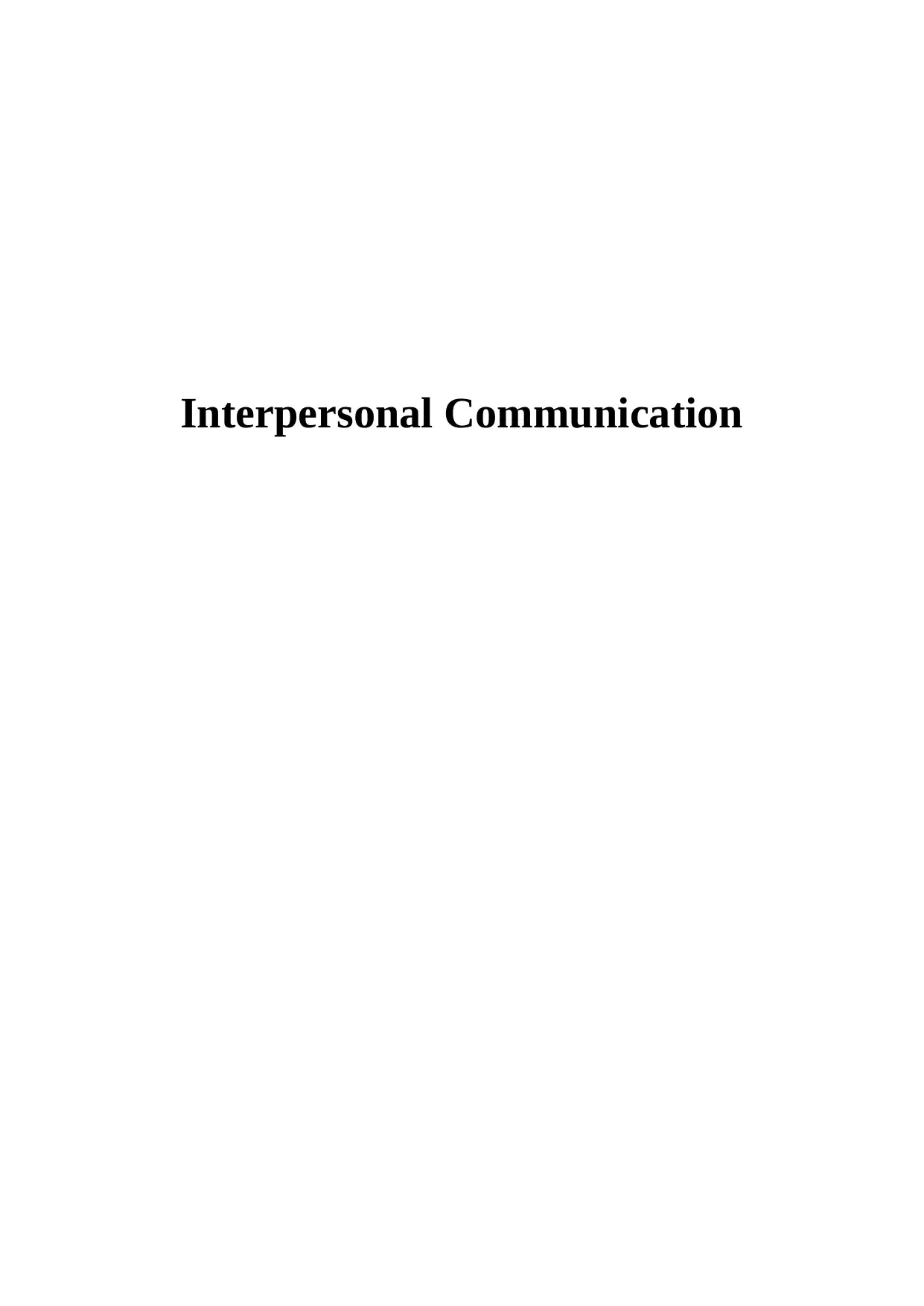
Interpersonal Communication
Paraphrase This Document
Need a fresh take? Get an instant paraphrase of this document with our AI Paraphraser
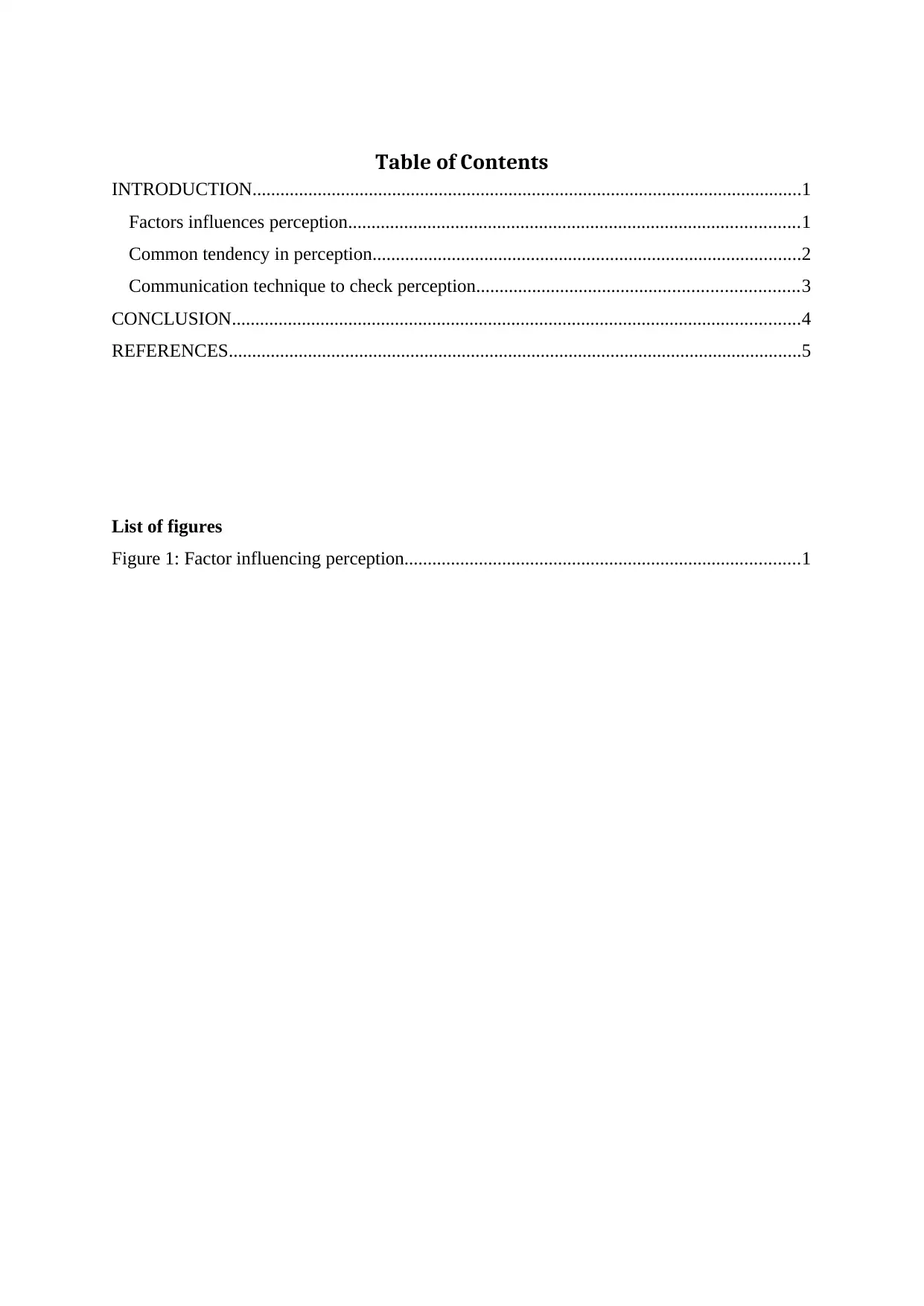
Table of Contents
INTRODUCTION......................................................................................................................1
Factors influences perception.................................................................................................1
Common tendency in perception............................................................................................2
Communication technique to check perception.....................................................................3
CONCLUSION..........................................................................................................................4
REFERENCES...........................................................................................................................5
List of figures
Figure 1: Factor influencing perception.....................................................................................1
INTRODUCTION......................................................................................................................1
Factors influences perception.................................................................................................1
Common tendency in perception............................................................................................2
Communication technique to check perception.....................................................................3
CONCLUSION..........................................................................................................................4
REFERENCES...........................................................................................................................5
List of figures
Figure 1: Factor influencing perception.....................................................................................1
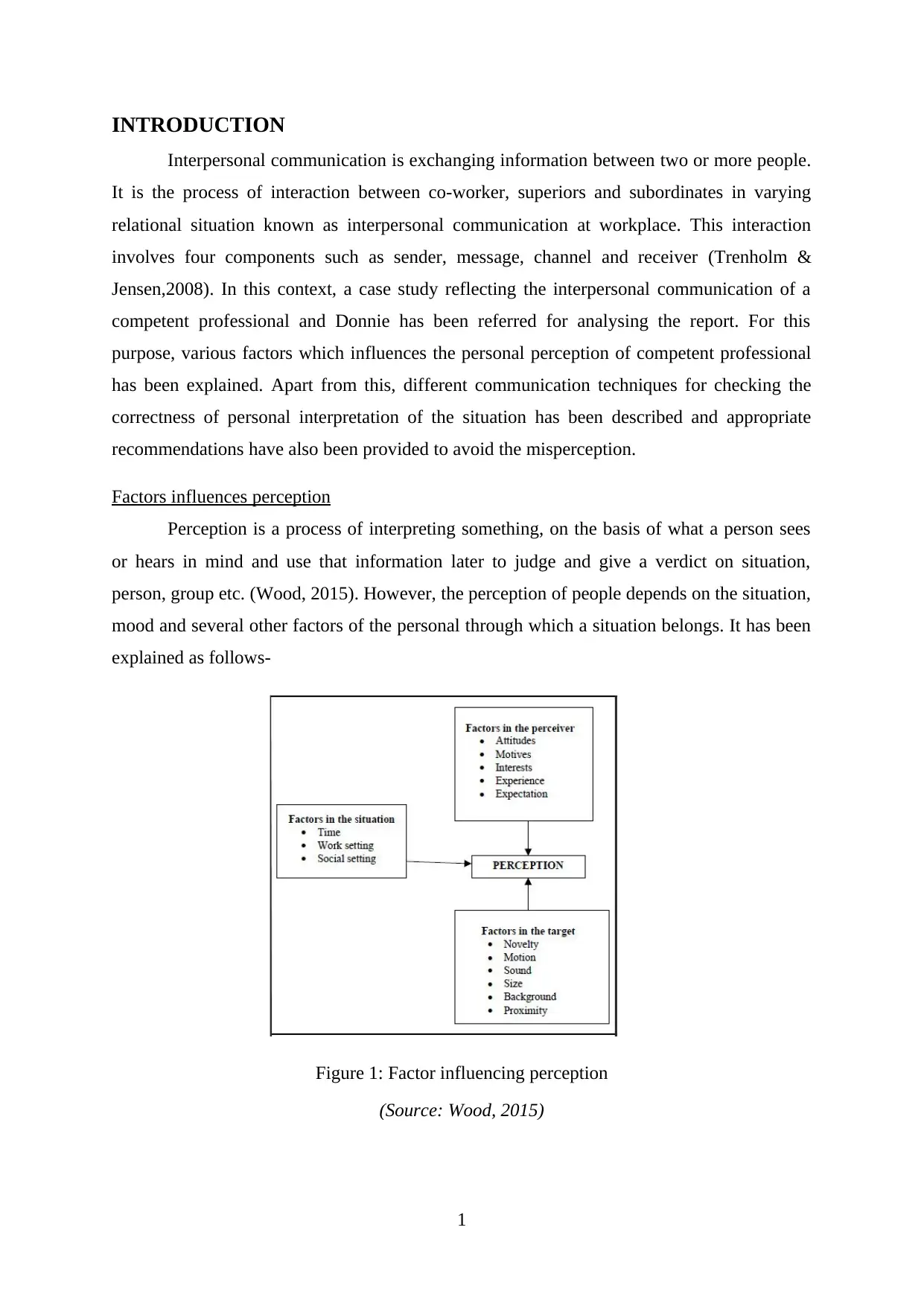
INTRODUCTION
Interpersonal communication is exchanging information between two or more people.
It is the process of interaction between co-worker, superiors and subordinates in varying
relational situation known as interpersonal communication at workplace. This interaction
involves four components such as sender, message, channel and receiver (Trenholm &
Jensen,2008). In this context, a case study reflecting the interpersonal communication of a
competent professional and Donnie has been referred for analysing the report. For this
purpose, various factors which influences the personal perception of competent professional
has been explained. Apart from this, different communication techniques for checking the
correctness of personal interpretation of the situation has been described and appropriate
recommendations have also been provided to avoid the misperception.
Factors influences perception
Perception is a process of interpreting something, on the basis of what a person sees
or hears in mind and use that information later to judge and give a verdict on situation,
person, group etc. (Wood, 2015). However, the perception of people depends on the situation,
mood and several other factors of the personal through which a situation belongs. It has been
explained as follows-
Figure 1: Factor influencing perception
(Source: Wood, 2015)
1
Interpersonal communication is exchanging information between two or more people.
It is the process of interaction between co-worker, superiors and subordinates in varying
relational situation known as interpersonal communication at workplace. This interaction
involves four components such as sender, message, channel and receiver (Trenholm &
Jensen,2008). In this context, a case study reflecting the interpersonal communication of a
competent professional and Donnie has been referred for analysing the report. For this
purpose, various factors which influences the personal perception of competent professional
has been explained. Apart from this, different communication techniques for checking the
correctness of personal interpretation of the situation has been described and appropriate
recommendations have also been provided to avoid the misperception.
Factors influences perception
Perception is a process of interpreting something, on the basis of what a person sees
or hears in mind and use that information later to judge and give a verdict on situation,
person, group etc. (Wood, 2015). However, the perception of people depends on the situation,
mood and several other factors of the personal through which a situation belongs. It has been
explained as follows-
Figure 1: Factor influencing perception
(Source: Wood, 2015)
1
⊘ This is a preview!⊘
Do you want full access?
Subscribe today to unlock all pages.

Trusted by 1+ million students worldwide
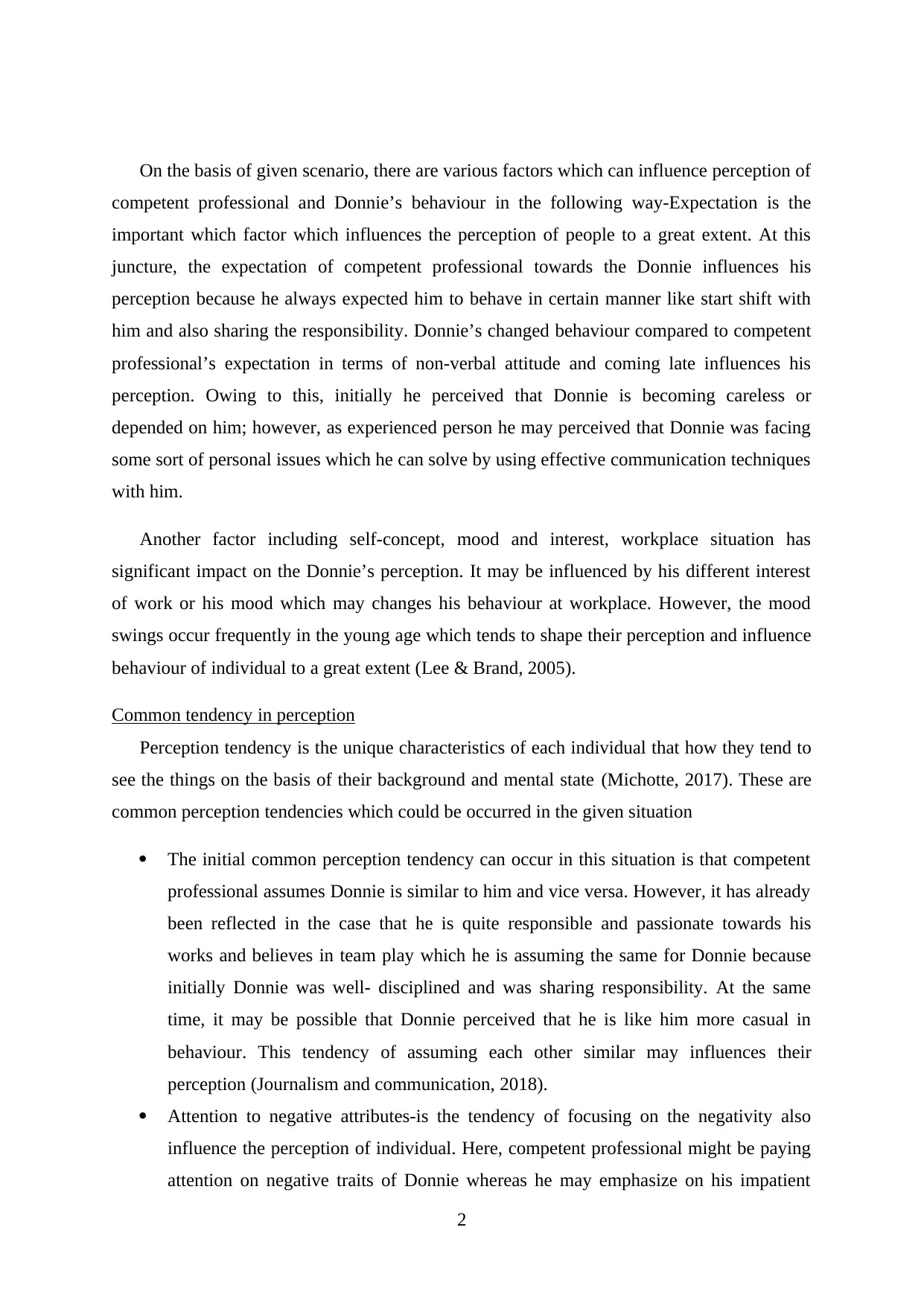
On the basis of given scenario, there are various factors which can influence perception of
competent professional and Donnie’s behaviour in the following way-Expectation is the
important which factor which influences the perception of people to a great extent. At this
juncture, the expectation of competent professional towards the Donnie influences his
perception because he always expected him to behave in certain manner like start shift with
him and also sharing the responsibility. Donnie’s changed behaviour compared to competent
professional’s expectation in terms of non-verbal attitude and coming late influences his
perception. Owing to this, initially he perceived that Donnie is becoming careless or
depended on him; however, as experienced person he may perceived that Donnie was facing
some sort of personal issues which he can solve by using effective communication techniques
with him.
Another factor including self-concept, mood and interest, workplace situation has
significant impact on the Donnie’s perception. It may be influenced by his different interest
of work or his mood which may changes his behaviour at workplace. However, the mood
swings occur frequently in the young age which tends to shape their perception and influence
behaviour of individual to a great extent (Lee & Brand, 2005).
Common tendency in perception
Perception tendency is the unique characteristics of each individual that how they tend to
see the things on the basis of their background and mental state (Michotte, 2017). These are
common perception tendencies which could be occurred in the given situation
The initial common perception tendency can occur in this situation is that competent
professional assumes Donnie is similar to him and vice versa. However, it has already
been reflected in the case that he is quite responsible and passionate towards his
works and believes in team play which he is assuming the same for Donnie because
initially Donnie was well- disciplined and was sharing responsibility. At the same
time, it may be possible that Donnie perceived that he is like him more casual in
behaviour. This tendency of assuming each other similar may influences their
perception (Journalism and communication, 2018).
Attention to negative attributes-is the tendency of focusing on the negativity also
influence the perception of individual. Here, competent professional might be paying
attention on negative traits of Donnie whereas he may emphasize on his impatient
2
competent professional and Donnie’s behaviour in the following way-Expectation is the
important which factor which influences the perception of people to a great extent. At this
juncture, the expectation of competent professional towards the Donnie influences his
perception because he always expected him to behave in certain manner like start shift with
him and also sharing the responsibility. Donnie’s changed behaviour compared to competent
professional’s expectation in terms of non-verbal attitude and coming late influences his
perception. Owing to this, initially he perceived that Donnie is becoming careless or
depended on him; however, as experienced person he may perceived that Donnie was facing
some sort of personal issues which he can solve by using effective communication techniques
with him.
Another factor including self-concept, mood and interest, workplace situation has
significant impact on the Donnie’s perception. It may be influenced by his different interest
of work or his mood which may changes his behaviour at workplace. However, the mood
swings occur frequently in the young age which tends to shape their perception and influence
behaviour of individual to a great extent (Lee & Brand, 2005).
Common tendency in perception
Perception tendency is the unique characteristics of each individual that how they tend to
see the things on the basis of their background and mental state (Michotte, 2017). These are
common perception tendencies which could be occurred in the given situation
The initial common perception tendency can occur in this situation is that competent
professional assumes Donnie is similar to him and vice versa. However, it has already
been reflected in the case that he is quite responsible and passionate towards his
works and believes in team play which he is assuming the same for Donnie because
initially Donnie was well- disciplined and was sharing responsibility. At the same
time, it may be possible that Donnie perceived that he is like him more casual in
behaviour. This tendency of assuming each other similar may influences their
perception (Journalism and communication, 2018).
Attention to negative attributes-is the tendency of focusing on the negativity also
influence the perception of individual. Here, competent professional might be paying
attention on negative traits of Donnie whereas he may emphasize on his impatient
2
Paraphrase This Document
Need a fresh take? Get an instant paraphrase of this document with our AI Paraphraser
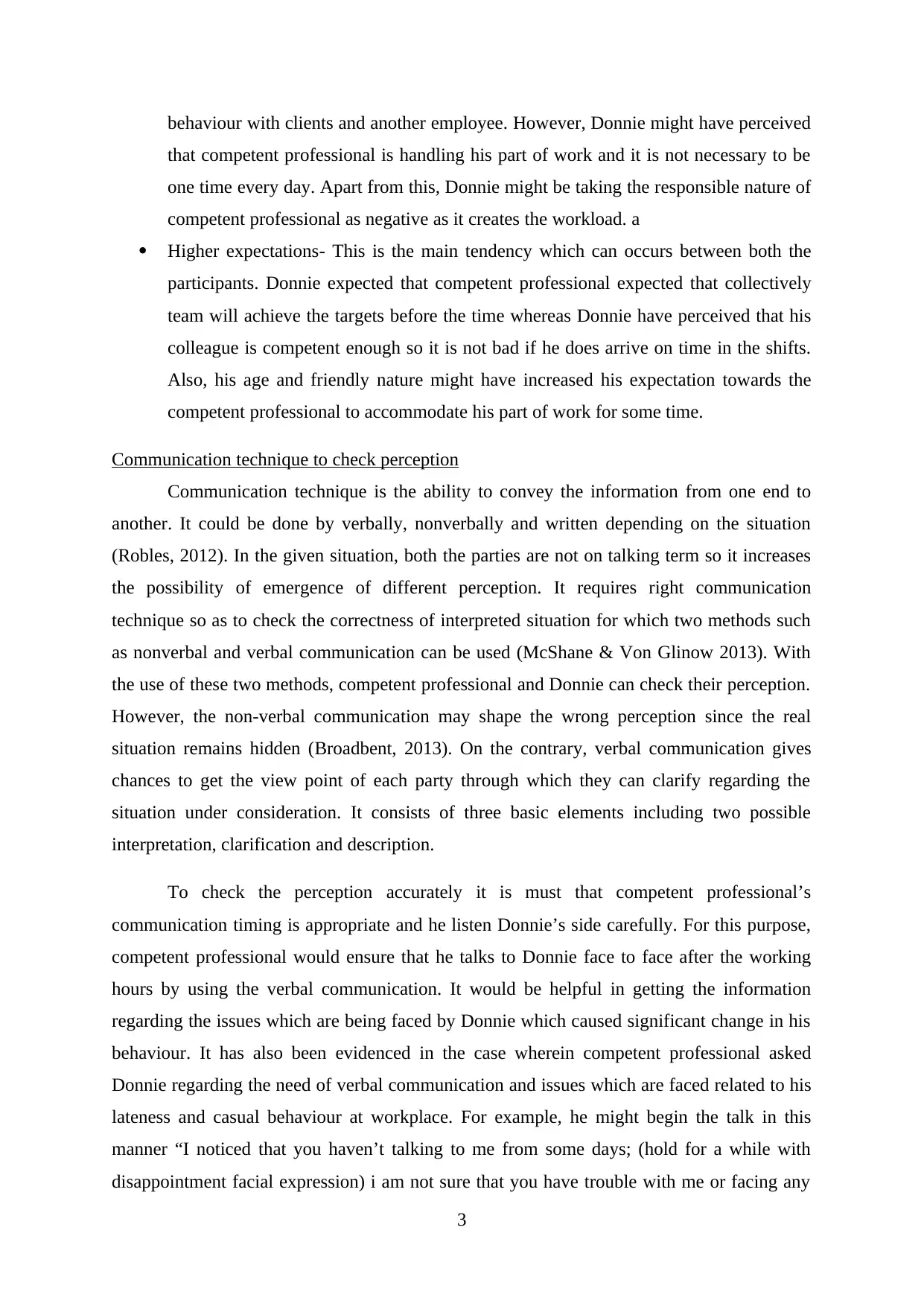
behaviour with clients and another employee. However, Donnie might have perceived
that competent professional is handling his part of work and it is not necessary to be
one time every day. Apart from this, Donnie might be taking the responsible nature of
competent professional as negative as it creates the workload. a
Higher expectations- This is the main tendency which can occurs between both the
participants. Donnie expected that competent professional expected that collectively
team will achieve the targets before the time whereas Donnie have perceived that his
colleague is competent enough so it is not bad if he does arrive on time in the shifts.
Also, his age and friendly nature might have increased his expectation towards the
competent professional to accommodate his part of work for some time.
Communication technique to check perception
Communication technique is the ability to convey the information from one end to
another. It could be done by verbally, nonverbally and written depending on the situation
(Robles, 2012). In the given situation, both the parties are not on talking term so it increases
the possibility of emergence of different perception. It requires right communication
technique so as to check the correctness of interpreted situation for which two methods such
as nonverbal and verbal communication can be used (McShane & Von Glinow 2013). With
the use of these two methods, competent professional and Donnie can check their perception.
However, the non-verbal communication may shape the wrong perception since the real
situation remains hidden (Broadbent, 2013). On the contrary, verbal communication gives
chances to get the view point of each party through which they can clarify regarding the
situation under consideration. It consists of three basic elements including two possible
interpretation, clarification and description.
To check the perception accurately it is must that competent professional’s
communication timing is appropriate and he listen Donnie’s side carefully. For this purpose,
competent professional would ensure that he talks to Donnie face to face after the working
hours by using the verbal communication. It would be helpful in getting the information
regarding the issues which are being faced by Donnie which caused significant change in his
behaviour. It has also been evidenced in the case wherein competent professional asked
Donnie regarding the need of verbal communication and issues which are faced related to his
lateness and casual behaviour at workplace. For example, he might begin the talk in this
manner “I noticed that you haven’t talking to me from some days; (hold for a while with
disappointment facial expression) i am not sure that you have trouble with me or facing any
3
that competent professional is handling his part of work and it is not necessary to be
one time every day. Apart from this, Donnie might be taking the responsible nature of
competent professional as negative as it creates the workload. a
Higher expectations- This is the main tendency which can occurs between both the
participants. Donnie expected that competent professional expected that collectively
team will achieve the targets before the time whereas Donnie have perceived that his
colleague is competent enough so it is not bad if he does arrive on time in the shifts.
Also, his age and friendly nature might have increased his expectation towards the
competent professional to accommodate his part of work for some time.
Communication technique to check perception
Communication technique is the ability to convey the information from one end to
another. It could be done by verbally, nonverbally and written depending on the situation
(Robles, 2012). In the given situation, both the parties are not on talking term so it increases
the possibility of emergence of different perception. It requires right communication
technique so as to check the correctness of interpreted situation for which two methods such
as nonverbal and verbal communication can be used (McShane & Von Glinow 2013). With
the use of these two methods, competent professional and Donnie can check their perception.
However, the non-verbal communication may shape the wrong perception since the real
situation remains hidden (Broadbent, 2013). On the contrary, verbal communication gives
chances to get the view point of each party through which they can clarify regarding the
situation under consideration. It consists of three basic elements including two possible
interpretation, clarification and description.
To check the perception accurately it is must that competent professional’s
communication timing is appropriate and he listen Donnie’s side carefully. For this purpose,
competent professional would ensure that he talks to Donnie face to face after the working
hours by using the verbal communication. It would be helpful in getting the information
regarding the issues which are being faced by Donnie which caused significant change in his
behaviour. It has also been evidenced in the case wherein competent professional asked
Donnie regarding the need of verbal communication and issues which are faced related to his
lateness and casual behaviour at workplace. For example, he might begin the talk in this
manner “I noticed that you haven’t talking to me from some days; (hold for a while with
disappointment facial expression) i am not sure that you have trouble with me or facing any
3
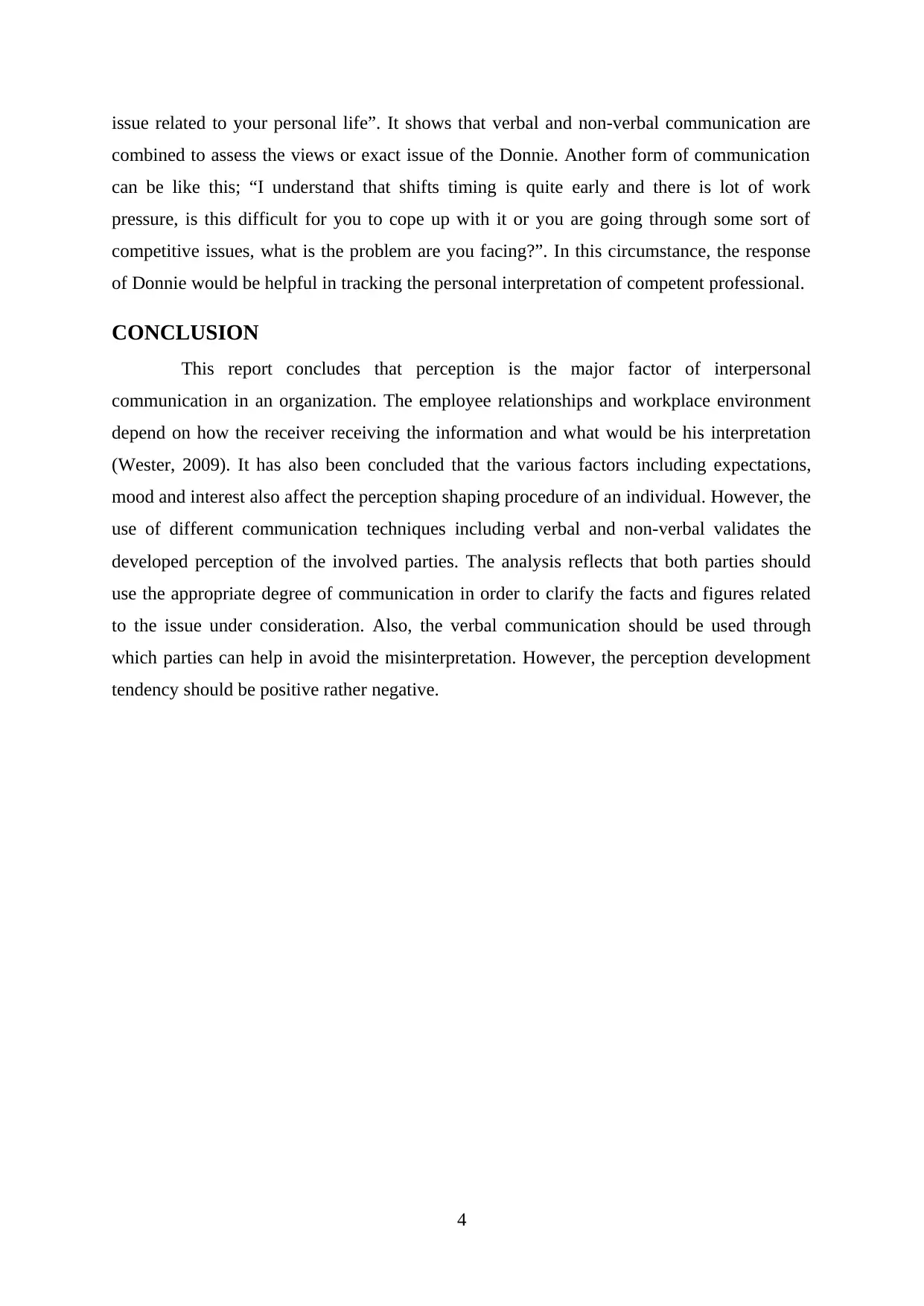
issue related to your personal life”. It shows that verbal and non-verbal communication are
combined to assess the views or exact issue of the Donnie. Another form of communication
can be like this; “I understand that shifts timing is quite early and there is lot of work
pressure, is this difficult for you to cope up with it or you are going through some sort of
competitive issues, what is the problem are you facing?”. In this circumstance, the response
of Donnie would be helpful in tracking the personal interpretation of competent professional.
CONCLUSION
This report concludes that perception is the major factor of interpersonal
communication in an organization. The employee relationships and workplace environment
depend on how the receiver receiving the information and what would be his interpretation
(Wester, 2009). It has also been concluded that the various factors including expectations,
mood and interest also affect the perception shaping procedure of an individual. However, the
use of different communication techniques including verbal and non-verbal validates the
developed perception of the involved parties. The analysis reflects that both parties should
use the appropriate degree of communication in order to clarify the facts and figures related
to the issue under consideration. Also, the verbal communication should be used through
which parties can help in avoid the misinterpretation. However, the perception development
tendency should be positive rather negative.
4
combined to assess the views or exact issue of the Donnie. Another form of communication
can be like this; “I understand that shifts timing is quite early and there is lot of work
pressure, is this difficult for you to cope up with it or you are going through some sort of
competitive issues, what is the problem are you facing?”. In this circumstance, the response
of Donnie would be helpful in tracking the personal interpretation of competent professional.
CONCLUSION
This report concludes that perception is the major factor of interpersonal
communication in an organization. The employee relationships and workplace environment
depend on how the receiver receiving the information and what would be his interpretation
(Wester, 2009). It has also been concluded that the various factors including expectations,
mood and interest also affect the perception shaping procedure of an individual. However, the
use of different communication techniques including verbal and non-verbal validates the
developed perception of the involved parties. The analysis reflects that both parties should
use the appropriate degree of communication in order to clarify the facts and figures related
to the issue under consideration. Also, the verbal communication should be used through
which parties can help in avoid the misinterpretation. However, the perception development
tendency should be positive rather negative.
4
⊘ This is a preview!⊘
Do you want full access?
Subscribe today to unlock all pages.

Trusted by 1+ million students worldwide
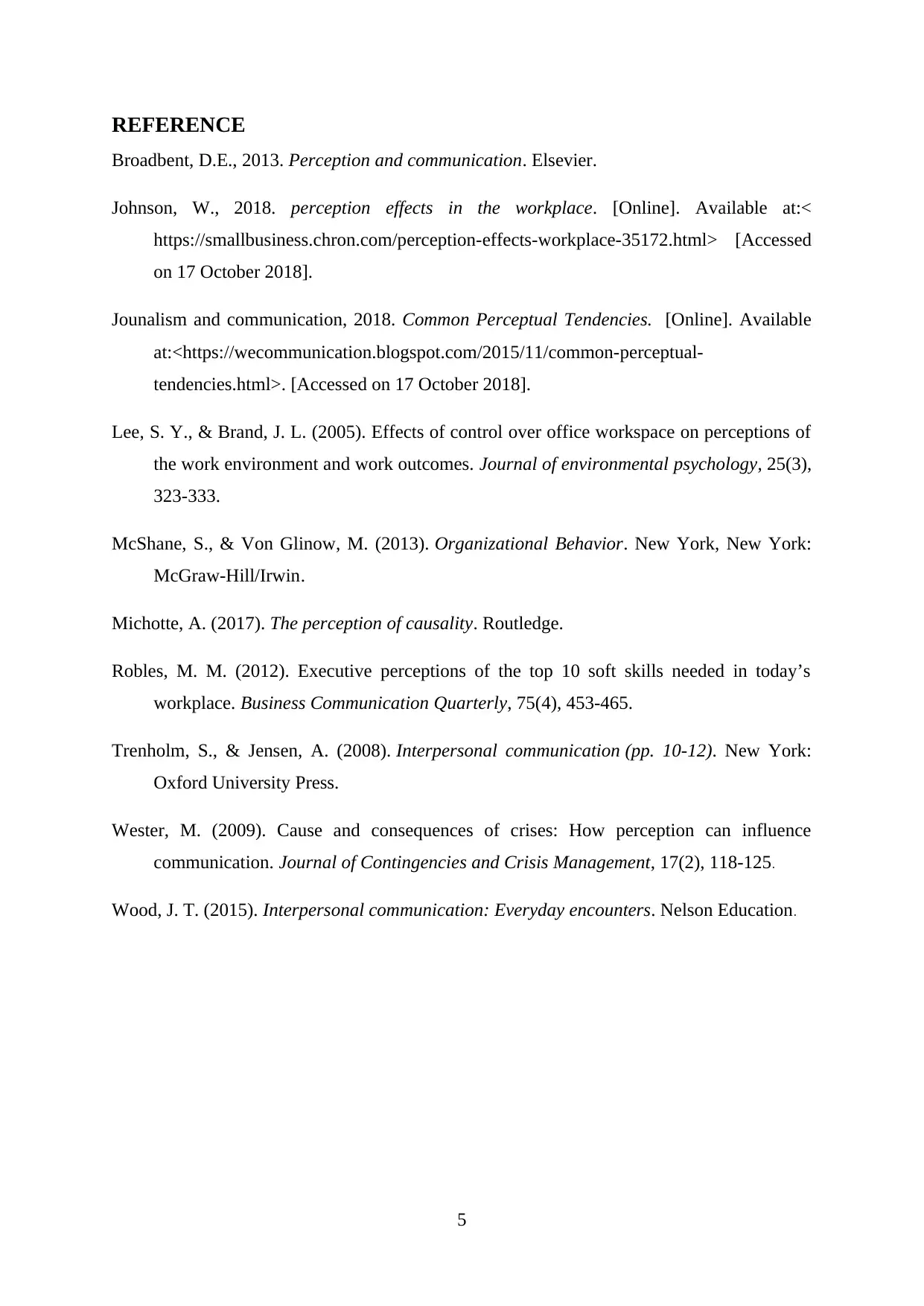
REFERENCE
Broadbent, D.E., 2013. Perception and communication. Elsevier.
Johnson, W., 2018. perception effects in the workplace. [Online]. Available at:<
https://smallbusiness.chron.com/perception-effects-workplace-35172.html> [Accessed
on 17 October 2018].
Jounalism and communication, 2018. Common Perceptual Tendencies. [Online]. Available
at:<https://wecommunication.blogspot.com/2015/11/common-perceptual-
tendencies.html>. [Accessed on 17 October 2018].
Lee, S. Y., & Brand, J. L. (2005). Effects of control over office workspace on perceptions of
the work environment and work outcomes. Journal of environmental psychology, 25(3),
323-333.
McShane, S., & Von Glinow, M. (2013). Organizational Behavior. New York, New York:
McGraw-Hill/Irwin.
Michotte, A. (2017). The perception of causality. Routledge.
Robles, M. M. (2012). Executive perceptions of the top 10 soft skills needed in today’s
workplace. Business Communication Quarterly, 75(4), 453-465.
Trenholm, S., & Jensen, A. (2008). Interpersonal communication (pp. 10-12). New York:
Oxford University Press.
Wester, M. (2009). Cause and consequences of crises: How perception can influence
communication. Journal of Contingencies and Crisis Management, 17(2), 118-125.
Wood, J. T. (2015). Interpersonal communication: Everyday encounters. Nelson Education.
5
Broadbent, D.E., 2013. Perception and communication. Elsevier.
Johnson, W., 2018. perception effects in the workplace. [Online]. Available at:<
https://smallbusiness.chron.com/perception-effects-workplace-35172.html> [Accessed
on 17 October 2018].
Jounalism and communication, 2018. Common Perceptual Tendencies. [Online]. Available
at:<https://wecommunication.blogspot.com/2015/11/common-perceptual-
tendencies.html>. [Accessed on 17 October 2018].
Lee, S. Y., & Brand, J. L. (2005). Effects of control over office workspace on perceptions of
the work environment and work outcomes. Journal of environmental psychology, 25(3),
323-333.
McShane, S., & Von Glinow, M. (2013). Organizational Behavior. New York, New York:
McGraw-Hill/Irwin.
Michotte, A. (2017). The perception of causality. Routledge.
Robles, M. M. (2012). Executive perceptions of the top 10 soft skills needed in today’s
workplace. Business Communication Quarterly, 75(4), 453-465.
Trenholm, S., & Jensen, A. (2008). Interpersonal communication (pp. 10-12). New York:
Oxford University Press.
Wester, M. (2009). Cause and consequences of crises: How perception can influence
communication. Journal of Contingencies and Crisis Management, 17(2), 118-125.
Wood, J. T. (2015). Interpersonal communication: Everyday encounters. Nelson Education.
5
Paraphrase This Document
Need a fresh take? Get an instant paraphrase of this document with our AI Paraphraser

6
1 out of 8
Related Documents
Your All-in-One AI-Powered Toolkit for Academic Success.
+13062052269
info@desklib.com
Available 24*7 on WhatsApp / Email
![[object Object]](/_next/static/media/star-bottom.7253800d.svg)
Unlock your academic potential
Copyright © 2020–2025 A2Z Services. All Rights Reserved. Developed and managed by ZUCOL.





